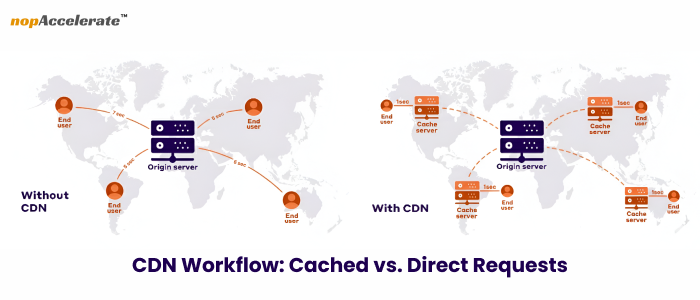Enjoyed this post?
Be sure to subscribe to the nopAccelerate newsletter and get regular updates about awesome posts just like this one and more!

An ecommerce store with 10,000+ products and hundreds of pages can quickly become slow and unresponsive.
Shoppers come with intent to buy, but instead of browsing smoothly, they wait… and wait. A few seconds later, frustration takes over. The result? They bounce.
This is not just a minor inconvenience, it’s a conversion killer. Studies show that even a 1-second delay in page load time can slash conversions by up to 7%. For ecommerce stores, slow websites mean lower sales, higher cart abandonment, and declining customer trust.
So, how do you speed up your ecommerce website without compromising on design or features? One of the most effective solutions is a Content Delivery Network (CDN), a powerful way to make your site faster, smoother, and more reliable.
In this blog, we’ll cover:
By the end, you’ll understand exactly how CDNs help transform ecommerce stores from sluggish to seamless and why it matters for your customers and your bottom line.
A Content Delivery Network (CDN) is essentially a network of servers distributed across the globe. Instead of delivering your ecommerce store’s content from a single hosting server (which could be thousands of miles away from your shopper), a CDN ensures that content is delivered from the nearest server location.
Think of it as building local warehouses for your products. Instead of shipping everything from your central headquarters, you store items in multiple regional hubs. When a customer orders, the product comes from the closest warehouse, ensuring fast delivery. A CDN does the same — but with web pages, product images, scripts, and videos.
Faster Load Times: Product pages, category filters, and checkout steps load faster because content is cached closer to the user.
Better User Experience: Shoppers enjoy seamless browsing without frustrating delays.
Reduced Bounce Rates: Visitors are less likely to abandon a slow site.
Improved Conversions: Speed directly impacts sales, faster websites convert more visitors into buyers.
Scalability & Reliability: Even during traffic spikes (holiday sales, flash deals), CDNs balance the load across servers, keeping the site stable.
At its core, a Content Delivery Network (CDN) is like an intelligent traffic manager for your ecommerce website. Instead of every visitor connecting directly to your central server, a CDN routes requests through a network of strategically placed servers (called edge servers) around the world.
Here’s how it works in practice:
This process happens in milliseconds, making your site appear faster and more responsive, even during peak demand.
CDNs don’t just accelerate load times. They also add important layers of security and scalability:
Many leading ecommerce platforms already include or support CDN integration to optimize store performance. For example:
Shopify offers built-in CDN coverage.
Magento stores often use third-party CDN services.
WooCommerce integrates CDN plugins for faster content delivery.
BigCommerce provides CDN as part of its infrastructure.
nopCommerce users have access to specialized CDN solutions.
For nopCommerce, If you want to explore this further, check out our deep dive into CDN solutions for nopCommerce
| Metric | Before CDN | After CDN |
| Page Load Time | 5–8 seconds | 1–3 seconds |
| Bounce Rate | 50%+ | <30% |
| Cart Abandonment Rate | 70%+ | <50% |
| Conversion Rate | 1–2% | 3–5% |
| Customer Perception | “Slow, unreliable” | “Fast, professional” |

A CDN speeds up your site, but pairing it with best practices maximizes results:
1. Mobile Optimization- Responsive design, fast-loading mobile themes, and simplified mobile checkout.
2. Image Compression & Optimization- Smaller file sizes, WebP format, and lazy loading for product photos.
3. Optimize the Checkout Flow- Offer guest checkout, one-page checkout, and multiple payment options.
4. Script Management- Limit third-party scripts that slow load times.
5. Caching and Database Optimization- Index product data and cache dynamic content in Ecommerce Website.
6. Monitor and Measure Performance- Track results with PageSpeed Insights, GTmetrix, and analytics tools.
7. Focus on UX Alongside Speed- Combine fast load times with intuitive navigation, clear product descriptions, and trustworthy design.
In ecommerce, every second matters. A store with 10,000+ products can’t afford to make customers wait. Slow websites lead to high bounce rates, abandoned carts, and lost sales opportunities. On the other hand, a fast, responsive store builds trust, keeps shoppers engaged, and turns browsing into buying.
A Content Delivery Network (CDN) is one of the most effective solutions for speeding up ecommerce websites. By delivering content from servers closer to shoppers, CDNs cut latency, improve page load times, and make browsing seamless worldwide. Whether it’s reducing cart abandonment, boosting conversions, or creating a more professional brand impression, the benefits are undeniable.
If you’re looking to fix a slow nopCommerce store, start by exploring CDN Plugins & Solutions.
Because in ecommerce, speed doesn’t just serve your customers. Speed sells.
Leave A Comment